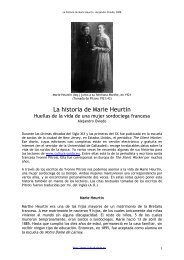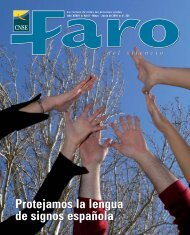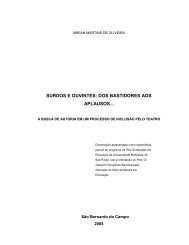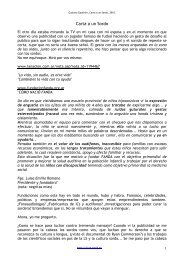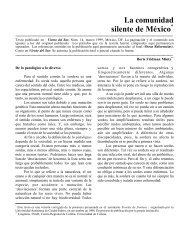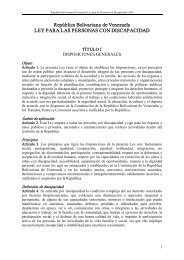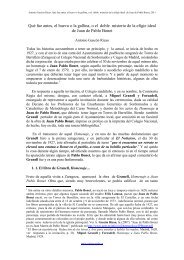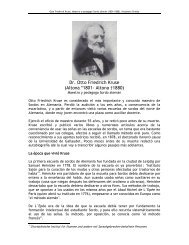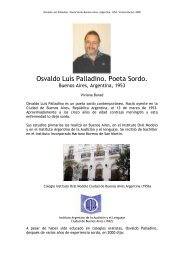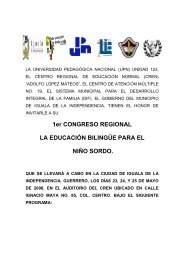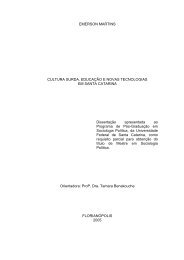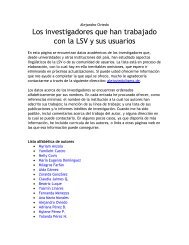- Page 1 and 2:
UNIVERSIDAD DE MÁLAGA FACULTAD DE
- Page 3 and 4:
- III - DEDICATORIA A Toñi. Nadie
- Page 5 and 6:
- V - INDICE Introducción.........
- Page 7 and 8:
- VII - PARTE EMPÍRICA: Introducci
- Page 9 and 10:
INTRODUCCIÓN
- Page 11 and 12:
Introducción - XI - directamente,
- Page 13 and 14:
Introducción - XIII - El trabajo q
- Page 15 and 16:
CAPITULO I.- TEORIA DE LA MENTE: OR
- Page 17 and 18:
- 16 - Capítulo I.- Teoría de la
- Page 19 and 20:
- 18 - Capítulo I.- Teoría de la
- Page 21 and 22:
- 20 - Capítulo I.- Teoría de la
- Page 23 and 24:
- 22 - Capítulo I.- Teoría de la
- Page 25 and 26:
- 24 - Capítulo I.- Teoría de la
- Page 27 and 28:
- 26 - Capítulo I.- Teoría de la
- Page 29 and 30:
- 28 - Capítulo .I.- Teoría de la
- Page 31 and 32:
- 30 - Capítulo .I.- Teoría de la
- Page 33 and 34:
- 32 - Capítulo .I.- Teoría de la
- Page 35 and 36:
- 34 - Capítulo .I.- Teoría de la
- Page 37 and 38:
- 36 - Capítulo .I.- Teoría de la
- Page 39 and 40:
- 38 - Capítulo .I.- Teoría de la
- Page 41 and 42:
- 40 - Capítulo .I.- Teoría de la
- Page 43 and 44:
- 42 - Capítulo .I.- Teoría de la
- Page 45 and 46:
- 44 - Capítulo .I.- Teoría de la
- Page 47 and 48:
- 46 - Capítulo .I.- Teoría de la
- Page 49 and 50:
- 48 - Capítulo .I.- Teoría de la
- Page 51 and 52:
- 50 - Capítulo .I.- Teoría de la
- Page 53 and 54:
- 52 - Capítulo .I.- Teoría de la
- Page 55 and 56:
- 54 - Capítulo .I.- Teoría de la
- Page 57 and 58:
- 56 - Capítulo II.- Aproximacione
- Page 59 and 60:
- 58 - Capítulo II.- Aproximacione
- Page 61 and 62:
- 60 - Capítulo II.- Aproximacione
- Page 63 and 64:
- 62 - Capítulo II.- Aproximacione
- Page 65 and 66:
- 64 - Capítulo II.- Aproximacione
- Page 67 and 68:
- 66 - Capítulo II.- Aproximacione
- Page 69 and 70:
- 68 - Capítulo II.- Aproximacione
- Page 71 and 72:
- 70 - Capítulo II.- Aproximacione
- Page 73 and 74:
- 72 - Capítulo II.- Aproximacione
- Page 75 and 76:
- 74 - Capítulo II.- Aproximacione
- Page 77 and 78:
- 76 - Capítulo II.- Aproximacione
- Page 79 and 80:
- 78 - Capítulo II.- Aproximacione
- Page 81 and 82:
- 80 - Capítulo II.- Aproximacione
- Page 83 and 84:
- 82 - Capítulo II.- Aproximacione
- Page 85 and 86:
- 84 - Capítulo II.- Aproximacione
- Page 87 and 88:
- 86 - Capítulo II.- Aproximacione
- Page 89 and 90:
- 88 - Capítulo II.- Aproximacione
- Page 91 and 92:
- 90 - Capítulo II.- Aproximacione
- Page 93 and 94:
- 92 - Capítulo II.- Aproximacione
- Page 95 and 96:
- 94 - Capítulo II.- Aproximacione
- Page 97 and 98:
- 96 - Capítulo II.- Aproximacione
- Page 99 and 100:
- 98 - Capítulo II.- Aproximacione
- Page 101 and 102: CAPÍTULO III.- INVESTIGACIONES SOB
- Page 103 and 104: - 102 - Capítulo III.- Investigaci
- Page 105 and 106: - 104 - Capítulo III.- Investigaci
- Page 107 and 108: - 106 - Capítulo III.- Investigaci
- Page 109 and 110: - 108 - Capítulo III.- Investigaci
- Page 111 and 112: - 110 - Capítulo III.- Investigaci
- Page 113 and 114: - 112 - Capítulo III.- Investigaci
- Page 115 and 116: - 114 - Capítulo III.- Investigaci
- Page 117 and 118: - 116 - Capítulo III.- Investigaci
- Page 119 and 120: - 118 - Capítulo III.- Investigaci
- Page 121 and 122: - 120 - Capítulo III.- Investigaci
- Page 123 and 124: - 122 - Capítulo III.- Investigaci
- Page 125 and 126: - 124 - Capítulo III.- Investigaci
- Page 127 and 128: - 126 - Capítulo III.- Investigaci
- Page 129 and 130: - 128 - Capítulo III.- Investigaci
- Page 131 and 132: - 130 - Capítulo III.- Investigaci
- Page 133 and 134: - 132 - Capítulo III.- Investigaci
- Page 135 and 136: - 134 - Capítulo III.- Investigaci
- Page 137 and 138: - 136 - Capítulo III.- Investigaci
- Page 139 and 140: - 138 - Capítulo III.- Investigaci
- Page 141 and 142: - 140 - Capítulo III.- Investigaci
- Page 143 and 144: - 142 - Capítulo III.- Investigaci
- Page 145 and 146: - 144 - Capítulo III.- Investigaci
- Page 147 and 148: - 146 - Capítulo III.- Investigaci
- Page 149 and 150: - 148 - Capítulo III.- Investigaci
- Page 151: - 150 - Capítulo III.- Investigaci
- Page 155 and 156: INTRODUCCIÓN: PLANTEAMIENTO GENERA
- Page 157 and 158: - 156 - Introducción: Planteamient
- Page 159 and 160: Capítulo IV.- Objetivos e Hipótes
- Page 161 and 162: Capítulo IV.- Objetivos e Hipótes
- Page 163 and 164: Capítulo IV.- Objetivos e Hipótes
- Page 165 and 166: - 164 - Capítulo V.- Característi
- Page 167 and 168: - 166 - Capítulo V.- Característi
- Page 169 and 170: - 168 - Capítulo V.- Característi
- Page 171 and 172: - 170 - Capítulo V.- Característi
- Page 173 and 174: - 172 - Capítulo V.- Característi
- Page 175 and 176: Capítulo VI.- Procedimiento e Inst
- Page 177 and 178: Capítulo VI.- Procedimiento e Inst
- Page 179 and 180: Capítulo VI.- Procedimiento e Inst
- Page 181 and 182: Capítulo VI.- Procedimiento e Inst
- Page 183 and 184: Capítulo VI.- Procedimiento e Inst
- Page 185 and 186: Capítulo VI.- Procedimiento e Inst
- Page 187 and 188: Capítulo VI.- Procedimiento e Inst
- Page 189 and 190: Capítulo VI.- Procedimiento e Inst
- Page 191 and 192: Capítulo VI.- Procedimiento e Inst
- Page 193 and 194: Capítulo VI.- Procedimiento e Inst
- Page 195 and 196: Capítulo VI.- Procedimiento e Inst
- Page 197 and 198: Capítulo VI.- Procedimiento e Inst
- Page 199 and 200: Capítulo VI.- Procedimiento e Inst
- Page 201 and 202: Capítulo VI.- Procedimiento e Inst
- Page 203 and 204:
Capítulo VII.- Resultados del estu
- Page 205 and 206:
Capítulo VII.- Resultados del estu
- Page 207 and 208:
Capítulo VII.- Resultados del estu
- Page 209 and 210:
- 208 - Capítulo VII.- Resultados
- Page 211 and 212:
- 210 - Capítulo VII.- Resultados
- Page 213 and 214:
- 212 - Capítulo VII.- Resultados
- Page 215 and 216:
- 214 - Capítulo VII.- Resultados
- Page 217 and 218:
- 216 - Capítulo VII.- Resultados
- Page 219 and 220:
- 218 - Capítulo VII.- Resultados
- Page 221 and 222:
- 220 - Capítulo VII.- Resultados
- Page 223 and 224:
- 222 - Capítulo VII.- Resultados
- Page 225 and 226:
- 224 - Capítulo VII.- Resultados
- Page 227 and 228:
- 226 - Capítulo VII.- Resultados
- Page 229 and 230:
- 228 - Capítulo VII.- Resultados
- Page 231 and 232:
- 230 - Capítulo VII.- Resultados
- Page 233 and 234:
- 232 - Capítulo VII.- Resultados
- Page 235 and 236:
Capítulo VII.- Resultados del estu
- Page 237 and 238:
Capítulo VII.- Resultados del estu
- Page 239 and 240:
Capítulo VII.- Resultados del estu
- Page 241 and 242:
Capítulo VII.- Resultados del estu
- Page 243 and 244:
Capítulo VII.- Resultados del estu
- Page 245 and 246:
Capítulo VII.- Resultados del estu
- Page 247 and 248:
Capítulo VII.- Resultados del estu
- Page 249 and 250:
Capítulo VII.- Resultados del estu
- Page 251 and 252:
I.N.V. Capítulo VII.- Resultados d
- Page 253 and 254:
Capítulo VII.- Resultados del estu
- Page 255 and 256:
Capítulo VII.- Resultados del estu
- Page 257 and 258:
Capítulo VII.- Resultados del estu
- Page 259 and 260:
Capítulo VII.- Resultados del estu
- Page 261 and 262:
Capítulo VII.- Resultados del estu
- Page 263 and 264:
Capítulo VII.- Resultados del estu
- Page 265 and 266:
CAPÍTULO VIII.- CONCLUSIONES Y DIS
- Page 267 and 268:
Capítulo VIII.- Conclusiones y dis
- Page 269 and 270:
Capítulo VIII.- Conclusiones y dis
- Page 271 and 272:
Capítulo VIII.- Conclusiones y dis
- Page 273 and 274:
Capítulo VIII.- Conclusiones y dis
- Page 275 and 276:
Capítulo VIII.- Conclusiones y dis
- Page 277 and 278:
Capítulo VIII.- Conclusiones y dis
- Page 279 and 280:
Capítulo VIII.- Conclusiones y dis
- Page 281 and 282:
REFERENCIAS BIBLIOGRÁFICAS
- Page 283 and 284:
Bibliografía. - 282 - Clark, M.D.,
- Page 285 and 286:
Bibliografía. - 284 - Garfield, J.
- Page 287 and 288:
Bibliografía. - 286 - LaFrenière,
- Page 289 and 290:
Bibliografía. - 288 - Perner, J.,
- Page 291 and 292:
Bibliografía. - 290 - Russell, J.,
- Page 293 and 294:
ANEXOS
- Page 295 and 296:
Anexos - 294 - CUESTIONARIO SOBRE C
- Page 297 and 298:
Anexos - 296 - CUANTIFICACIÓN DE L
- Page 299 and 300:
ANEXO 3 HOJA DE REGISTRO DE LA ESCA
- Page 301 and 302:
Anexos - 300 -
- Page 303 and 304:
Anexos - 302 -
- Page 305 and 306:
Anexos - 304 - 304
- Page 307 and 308:
Anexos - 306 - TAREAS EMPLEADAS PAR
- Page 309 and 310:
Anexos - 308 - 2)¿Por qué cree es
- Page 311 and 312:
Anexos - 310 - TAREAS EMPLEADAS PAR
- Page 313:
Anexos - 312 - -Paco guarda pelota



